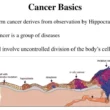Different Types of Cancer
Understanding Carcinomas, Sarcomas, Leukaemias, Lymphomas, and CNS Tumours: A Guide to Different Cancers
Cancer is actually a group of several diseases with different causes and symptoms rather than a single illness. The five main forms of cancer covered in this blog post are lymphomas, sarcomas, carcinomas, leukaemias, and tumours of the central nervous system. You can learn more about particular tumours and their treatment choices by being aware of these distinctions.
Different Types of Cancer
Table of Contents

- Carcinomas: The Most Common Type of Cancer; Epithelial cells are the source of carcinomas, the most common type of cancer. These cells make up the lining of our lungs, skin, breasts, intestines, and glands, among other organs and surfaces. Different Types of Cancer
As an illustration: Among the well-known carcinomas are:
Breast cancer
Cancer of the lung
colon cancer
Skin cancer, or melanoma
Cancer of the prostate
bladder cancer
How They Spread: Carcinomas can infiltrate nearby tissues and use the lymphatic or circulatory systems to travel (metastasize) to other organs.
Risk factors: Having a bad diet, smoking cigarettes, having chronic inflammation, and having specific genetic abnormalities can all raise your chance of getting carcinomas. - Sarcomas: Connective tissue cancers
Origin: The supporting tissues that bind our bodies together, called connective tissues, are the source of sarcomas. Bones, muscles, cartilage, fat, blood arteries, and lymph vessels are some examples of these tissues.Different Types of Cancer
As an illustration: Among the common types of sarcomas are osteosarcomas (bone cancer).
Cancer of the fatty tissue, liposarcoma
Cancer of the smooth muscle, or leiomyosarcoma
fibrous tissue cancer, or fibrosarcoma
How They Spread: The lymphatic or circulatory systems can both be used by sarcomas to spread to other areas of the body.
Risk factors include a family history of sarcomas, radiation therapy exposure, and certain genetic disorders. - Leukaemias: Blood and Bone Marrow tumours: Leukaemias are blood-forming tissue tumours, primarily found in the bone marrow. They have an impact on the development and operation of all blood types, including platelets, white blood cells, and red blood cells.
Types: Leukaemias fall into two primary categories:
Acute leukaemias: These are malignancies that grow quickly and spread quickly. Acute myeloid leukaemia (AML) and acute lymphoblastic leukaemia (ALL) are two examples.
Chronic leukaemias: These are cancers that grow more slowly over time. Chronic myeloid leukaemia (CML) and chronic lymphocytic leukaemia (CLL) are two examples.
Leukaemia symptoms might vary, however they may include weakness, exhaustion, fever, recurrent infections, and unusual bleeding.
Treatment: Chemotherapy, radiation therapy, targeted medicines, and bone marrow transplants are among the possible treatment modalities for leukaemia. - Lymphomas: Lymphatic System Cancers
Origin: The lymphatic system, a network of tissues and veins that is essential to the immune system, is where lymphomas start. They have an impact on lymphocytes, a subset of white blood cells that fight infection.Different Types of Cancer
Types: Lymphomas are categorised into two primary groups:
Hodgkin lymphoma: Although less common, this kind frequently cures more people.
Non-Hodgkin lymphoma: There are other subtypes in this more varied category.
Symptoms: Common signs of lymphomas include enlarged lymph nodes, fever, night sweats, and unexplained weight loss.
Treatment: Chemotherapy, radiation therapy, immunotherapy, or a combination of these methods may be used, depending on the kind and stage of the lymphoma. - Tumours of the Central Nervous System (CNS): Brain and Spinal Cord Cancers: Central nervous system (CNS) tumours can originate in the brain, spinal cord, or meninges, the membranes that surround the brain and spinal cord and provide protection.
categories: Based on the type of cell they originate from, CNS tumours can be classified into a wide variety of categories. Gliomas, meningiomas, and medulloblastomas are a few frequent forms.Different Types of Cancer
Symptoms: Headaches, seizures, vision issues, weakness, and trouble with balance or coordination are some of the symptoms of central nervous system (CNS) tumours. These symptoms might vary according on the location and size of the tumour.
Treatment: Common methods for treating CNS tumours include surgery, radiation therapy, and chemotherapy.Different Types of Cancer
Recall that while this is a broad summary, every type of cancer has unique traits, treatment alternatives, and prognoses. Seeking individualised advice from a healthcare practitioner is imperative.Different Types of Cancer


